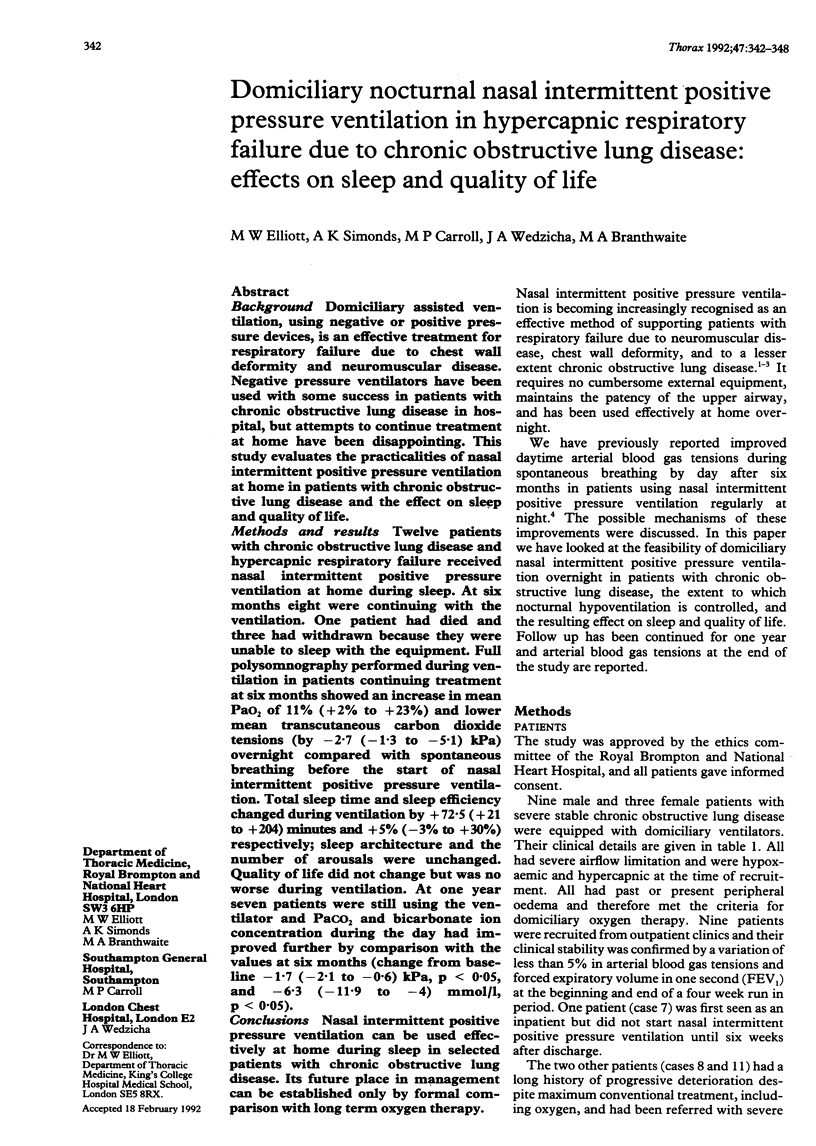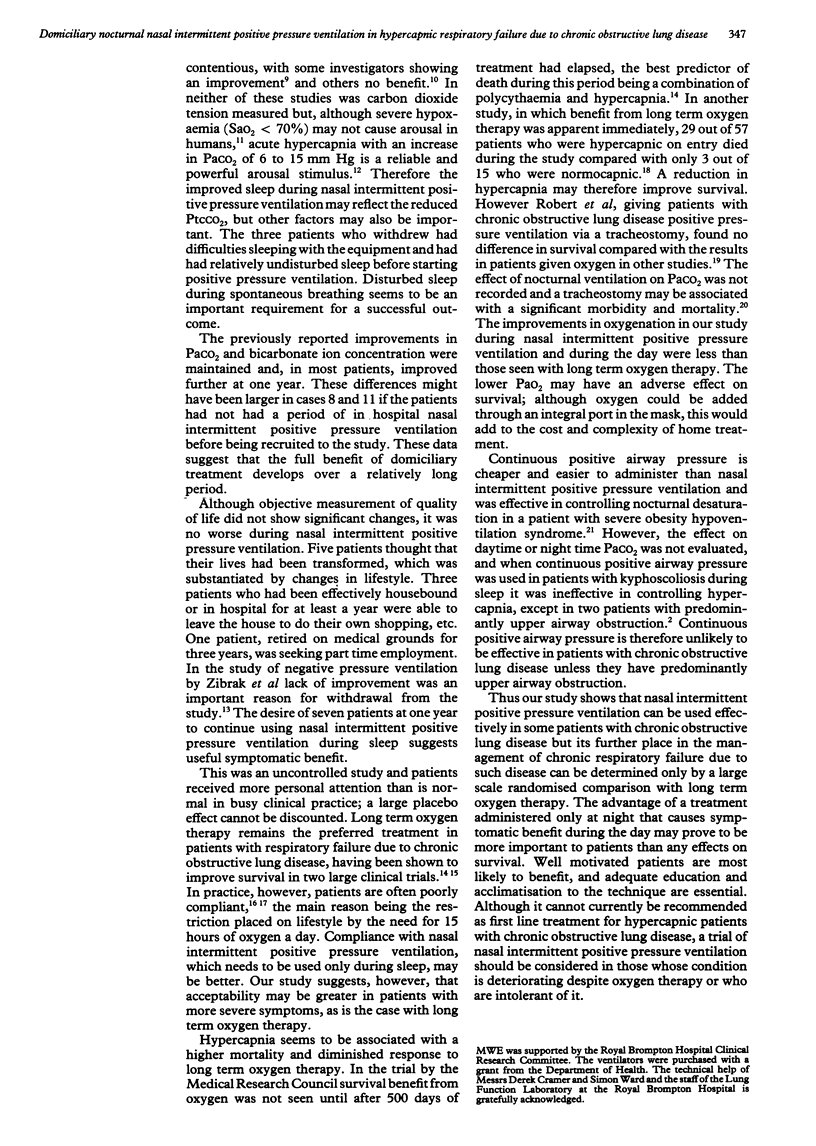Abstract
BACKGROUND: Domiciliary assisted ventilation, using negative or positive pressure devices, is an effective treatment for respiratory failure due to chest wall deformity and neuromuscular disease. Negative pressure ventilators have been used with some success in patients with chronic obstructive lung disease in hospital, but attempts to continue treatment at home have been disappointing. This study evaluates the practicalities of nasal intermittent positive pressure ventilation at home in patients with chronic obstructive lung disease and the effect on sleep and quality of life. METHODS AND RESULTS: Twelve patients with chronic obstructive lung disease and hypercapnic respiratory failure received nasal intermittent positive pressure ventilation at home during sleep. At six months eight were continuing with the ventilation. One patient had died and three had withdrawn because they were unable to sleep with the equipment. Full polysomnography performed during ventilation in patients continuing treatment at six months showed an increase in mean PaO2 of 11% (+2% to +23%) and lower mean transcutaneous carbon dioxide tensions (by -2.7 (-1.3 to -5.1) kPa) overnight compared with spontaneous breathing before the start of nasal intermittent positive pressure ventilation. Total sleep time and sleep efficiency changed during ventilation by +72.5 (+21 to +204) minutes and +5% (-3% to +30%) respectively; sleep architecture and the number of arousals were unchanged. Quality of life did not change but was no worse during ventilation. At one year seven patients were still using the ventilator and PaCO2 and bicarbonate ion concentration during the day had improved further by comparison with the values at six months (change from baseline -1.7 (-2.1 to -0.6) kPa, p less than 0.05, and -6.3 (-11.9 to -4) mmol/l, p less than 0.05). CONCLUSIONS: Nasal intermittent positive pressure ventilation can be used effectively at home during sleep in selected patients with chronic obstructive lung disease. Its future place in management can be established only by formal comparison with long term oxygen therapy.
Full text
PDF






Selected References
These references are in PubMed. This may not be the complete list of references from this article.
- Baudouin S. V., Waterhouse J. C., Tahtamouni T., Smith J. A., Baxter J., Howard P. Long term domiciliary oxygen treatment for chronic respiratory failure reviewed. Thorax. 1990 Mar;45(3):195–198. doi: 10.1136/thx.45.3.195. [DOI] [PMC free article] [PubMed] [Google Scholar]
- Berthon-Jones M., Sullivan C. E. Ventilatory and arousal responses to hypoxia in sleeping humans. Am Rev Respir Dis. 1982 Jun;125(6):632–639. doi: 10.1164/arrd.1982.125.6.632. [DOI] [PubMed] [Google Scholar]
- Calverley P. M., Brezinova V., Douglas N. J., Catterall J. R., Flenley D. C. The effect of oxygenation on sleep quality in chronic bronchitis and emphysema. Am Rev Respir Dis. 1982 Aug;126(2):206–210. doi: 10.1164/arrd.1982.126.2.206. [DOI] [PubMed] [Google Scholar]
- Carroll N., Branthwaite M. A. Control of nocturnal hypoventilation by nasal intermittent positive pressure ventilation. Thorax. 1988 May;43(5):349–353. doi: 10.1136/thx.43.5.349. [DOI] [PMC free article] [PubMed] [Google Scholar]
- Carroll N., Parker R. A., Branthwaite M. A. The use of protriptyline for respiratory failure in patients with chronic airflow limitation. Eur Respir J. 1990 Jul;3(7):746–751. [PubMed] [Google Scholar]
- Cooper C. B., Waterhouse J., Howard P. Twelve year clinical study of patients with hypoxic cor pulmonale given long term domiciliary oxygen therapy. Thorax. 1987 Feb;42(2):105–110. doi: 10.1136/thx.42.2.105. [DOI] [PMC free article] [PubMed] [Google Scholar]
- Elliott M. W., Mulvey D. A., Moxham J., Green M., Branthwaite M. A. Domiciliary nocturnal nasal intermittent positive pressure ventilation in COPD: mechanisms underlying changes in arterial blood gas tensions. Eur Respir J. 1991 Oct;4(9):1044–1052. [PubMed] [Google Scholar]
- Ellis E. R., Bye P. T., Bruderer J. W., Sullivan C. E. Treatment of respiratory failure during sleep in patients with neuromuscular disease. Positive-pressure ventilation through a nose mask. Am Rev Respir Dis. 1987 Jan;135(1):148–152. doi: 10.1164/arrd.1987.135.1.148. [DOI] [PubMed] [Google Scholar]
- Fleetham J., West P., Mezon B., Conway W., Roth T., Kryger M. Sleep, arousals, and oxygen desaturation in chronic obstructive pulmonary disease. The effect of oxygen therapy. Am Rev Respir Dis. 1982 Sep;126(3):429–433. doi: 10.1164/arrd.1982.126.3.429. [DOI] [PubMed] [Google Scholar]
- Guyatt G. H., Berman L. B., Townsend M., Pugsley S. O., Chambers L. W. A measure of quality of life for clinical trials in chronic lung disease. Thorax. 1987 Oct;42(10):773–778. doi: 10.1136/thx.42.10.773. [DOI] [PMC free article] [PubMed] [Google Scholar]
- Robert D., Gérard M., Leger P., Buffat J., Jennequin J., Holzapfel L., Mercatello A., Salamand J., Bertoye A. La ventilation mécanique à domicile définitive par trachéotomie de l'insuffisant respiratoire chronique. Rev Fr Mal Respir. 1983;11(6):923–936. [PubMed] [Google Scholar]
- Rossing T. H., Fanta C. H., McFadden E. R., Jr A controlled trial of the use of single versus combined-drug therapy in the treatment of acute episodes of asthma. Am Rev Respir Dis. 1981 Feb;123(2):190–194. doi: 10.1164/arrd.1981.123.2.190. [DOI] [PubMed] [Google Scholar]
- Stauffer J. L., Olson D. E., Petty T. L. Complications and consequences of endotracheal intubation and tracheotomy. A prospective study of 150 critically ill adult patients. Am J Med. 1981 Jan;70(1):65–76. doi: 10.1016/0002-9343(81)90413-7. [DOI] [PubMed] [Google Scholar]
- Sériès F., Cormier Y., La Forge J. Changes in day and night time oxygenation with protriptyline in patients with chronic obstructive lung disease. Thorax. 1989 Apr;44(4):275–279. doi: 10.1136/thx.44.4.275. [DOI] [PMC free article] [PubMed] [Google Scholar]
- Sériès F., Cormier Y., La Forge J. Non-apnoeic REM sleep induced nocturnal oxygen desaturation treated by nasal continuous positive airway pressure. Thorax. 1989 Jun;44(6):521–522. doi: 10.1136/thx.44.6.521. [DOI] [PMC free article] [PubMed] [Google Scholar]
- Tabka Z., Ben Jebria A., Vergeret J., Guenard H. Effect of dry warm air on respiratory water loss in children with exercise-induced asthma. Chest. 1988 Jul;94(1):81–86. doi: 10.1378/chest.94.1.81. [DOI] [PubMed] [Google Scholar]
- Walshaw M. J., Lim R., Evans C. C., Hind C. R. Factors influencing the compliance of patients using oxygen concentrators for long-term home oxygen therapy. Respir Med. 1990 Jul;84(4):331–333. doi: 10.1016/s0954-6111(08)80062-5. [DOI] [PubMed] [Google Scholar]
- Zibrak J. D., Hill N. S., Federman E. C., Kwa S. L., O'Donnell C. Evaluation of intermittent long-term negative-pressure ventilation in patients with severe chronic obstructive pulmonary disease. Am Rev Respir Dis. 1988 Dec;138(6):1515–1518. doi: 10.1164/ajrccm/138.6.1515. [DOI] [PubMed] [Google Scholar]


